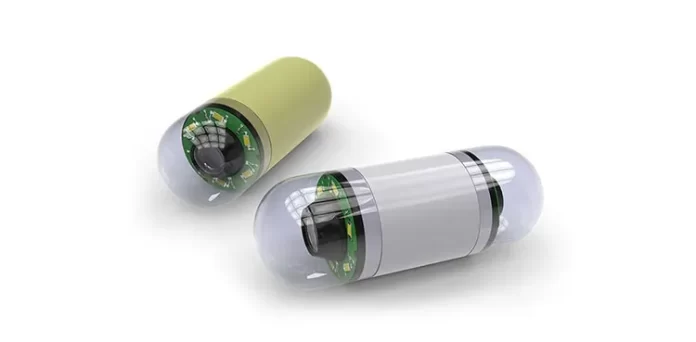The diagnosis and treatment of bowel diseases may be revolutionised by a smart pill the size of a blueberry, according to researchers from MIT, Boston University, and other institutions. This is due to the fact thaSmartPillt it is the first ingestion-compatible technology that can automatically identify important biological molecules that might be indicative of a problem and report on them in real time.
The research was published in Nature on August 10th. Researchers from the University of Chicago, Analogue Devices, and Brigham and Women’s Hospital in Boston are also authors on the paper.
The new study substantially expands on earlier research that was published in a Science issue from 2018. The size of the current pill, which complies with market-available safe, ingestible dosage forms, is roughly one-sixth that of the prototype described in Science. Additionally, it has been developed to recognise important biological molecules, including nitric oxide and hydrogen sulphide byproducts, which serve as important signals and mediators of the inflammation linked to bowel diseases.
Currently used methods for diagnosing diseases of the gastrointestinal tract can be invasive (consider a colonoscopy or other endoscopic procedure) and are unable to identify disease-related molecular biomarkers in real-time. The latter is problematic because a number of crucial biomarkers are short-lived and vanish before current methods can detect them.
The brand-new pill combines specially crafted living bacteria with electronics and a tiny battery and has been successfully tested in pigs. The bacteria themselves have been successfully tested outside of animals and in mice, and they emit light when they detect a molecule of interest. As the pill passes through the gut, the electronics in the pill transform that light into a wireless signal that can be transmitted through the body to a smartphone or other computer in real time.
One of science’s unexplored areas is the inner workings of the human gut. According to Timothy Lu, an associate professor of biological engineering, electrical engineering, and computer science at MIT, “our new pill could unlock a wealth of knowledge about the body’s function, its relationship with the environment, and the impact of disease and therapeutic interventions. The senior author of the study published in Nature is Lu, who is also connected to Senti Biosciences and MIT’s Materials Research Laboratory.
possible effect
Inflammatory bowel diseases (IBDs), such as colitis or Crohn’s disease, affect about 7 million people worldwide.
The anticipation of clinical flares, which frequently occur in these patients and require pharmacological management of their diseases, is one of the most difficult aspects of managing IBDs. According to Alessio Fassano, a professor at the Harvard T.H. Chan School of Public Health who was not involved in the study, patients frequently experience severe symptoms that necessitate hospitalisation in order to be properly managed because we currently lack robust biomarkers that predict an impending inflammatory flare. In terms of early diagnosis, preventing disease flare-ups, and optimising a therapeutic plan, this system “may represent a game changer in the management of IBDs.”
In their study, the researchers demonstrated that the smart pill could recognise nitric oxide, a transient molecule linked to numerous IBDs. Significantly, the sensors could also identify various nitric oxide concentrations. According to Maria Eugenia Inda, a Pew Postdoctoral Fellow in the MIT Departments of Electrical Engineering and Computer Science (EECS) and Biological Engineering (BE), “that will allow us to differentiate between a normal situation and disease. Additionally, patients’ biomarker levels differ greatly, making it crucial.
Recognising the gut
The team claims the pill could be modified to find additional important biomarkers. Inda is therefore also excited about the system’s potential to help scientists better understand the gut microbiome, or the delicate environment that houses the microbes essential to food digestion.
The gut is like a black box right now. “Because it’s hard to access and study, we still don’t fully understand it. We lack the resources to investigate it,” she claims. “By identifying factors that cause inflammation before the inflammation takes over, understanding more about the gut chemical environment could help us prevent disease,” says Dr. S.
One of the senior authors of the study and an associate professor of mechanical engineering at Brigham and Women’s Hospital named Giovanni Traverso says, “Through this development, we describe a unique platform for the evaluation of the GI tract, which we anticipate can help many.”
A wonderful journey
Inda compared the study to the 1966 movie “Fantastic Voyage,” in which four scientists shrink down to fit inside a tiny submarine that travels through a sick man’s arteries to treat a brain disorder. She smiles and says, “We scientists can’t do that, but now we can send bacteria to do something similar. We can now use living cells’ information-processing capabilities to diagnose disease in such inhospitable environments thanks to rapid advancements in synthetic biology.
Christoph Steiger, Alison Hayward, Adam Wentworth, Wiam Madani, Brigham and Women’s Hospital (BWH), MIT’s Koch Institute for Integrative Cancer Research, and Nhi Phan and Jenna Ahn are the coauthors of the Nature paper with Inda, Jimenez, Traverso, and Lu. MechE, the Koch Institute, and MIT’s Division of Comparative Medicine (DCM)’s Niora Fabian; Arslan Riaz, Timur Zirtiloglu, and Rabia Yazicigil of Boston University Electrical and Computer Engineering Department; Kaitlyn Wong and Ronan McNally of Boston Children’s Hospital; Keiko Ishida of the Koch Institute and Boston Children’s Hospital; Josh Jenkins and Johannes Kuosmanen of MechE and the
The MIT Department of Mechanical Engineering, the MIT Karl van Tassel (1925) Career Development Professorship, the Pew Charitable Trusts, the Translational Research Institute of Space Health, the Catalyst Foundation, and the Leona M. and Harry B. Helmsley Charitable Trust funded this research.






